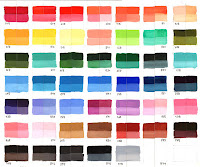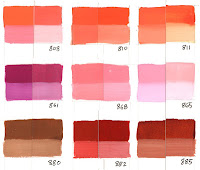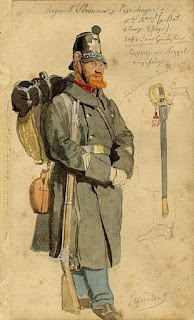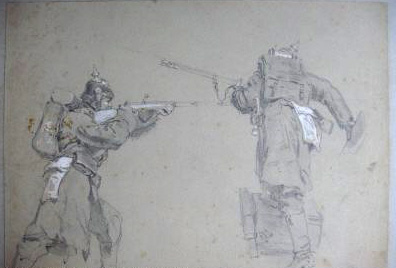Monday, September 30, 2019
WIRED Covers Color Constancy
Wired's Robbie Gonzalez visits neuroscientist David Eagleman to explore the perception of color constancy, which they demonstrate by building a large model of my diagram from Color and Light. (Direct link to YouTube) Nice work, you guys!
Sunday, September 29, 2019
Viennese Sign Painters
A Viennese sign painter explains how he created his handmade signs. Lately he's been working on his small museum, which shares lettering samples with the next generation.
----
When Better Letters met Josef Samuel: Vienna's Last Signpainter
Saturday, September 28, 2019
Phil Tippett Documentary Trailer
Here's a trailer (Link to YouTube) for a new documentary on stop motion animator Phil Tippett, who animated the Tauntauns and the Imperial walkers for Star Wars.
Since the CGI revolution, he has been working on personal projects such as Mad God (Link to YouTube) that extend the possibilities of stop motion in visualizing strange dreams. and equally strange and suggestive CGI / practical hybrids such as Mutant Land.
Friday, September 27, 2019
Your Questions about Painting

Vlad Kiperman: I always wonder how painters capture variable objects like clouds, passers-by, fluttering flags and such? In the time it takes to capture one of these, it has changed its shape, position and/or orientation. Do you memorize (does that take photographic memory)? Do you take a snapshot with your camera for later reference? Or is it a you've-seen-one-you've-seen-them-all kind of training? Also, painting a scene while setting up a video to capture it seems like complex stuff.
James Gurney: With flags or waves it's not too hard because they come back to similar positions. You just have to commit to a single phase of action. With people it's harder. I have asked random strangers to pose for a minute or two, and they've almost always been willing. I also often take a snapshot. For moving animals such as horses, you can bring maquettes of walking poses to set up in place. For more on the video capture methods, here's a blog post
-----
Marilene Sawaf: I have been using casein successfully for a few years now and usually varnish with acrylic varnish after a week, but lately I like my work without varnish...was wondering if not varnishing would be ok for the painting? Also the casein varnish they discontinued was terrible, it became brown in the can and split in two substances, one brown liquid and another one a milky gray substance...I think I will throw it away
James Gurney: You can use casein with or without varnish. If it's a dark valued painting, a varnish can give it a lot of depth. But if it's a light, pastel key I think the natural matte surface looks best. Try some of the modern spray varnishes and see which you like best. Try both on test swatches and see what you prefer. And if you're using casein unvarnished, remember that even if the values of the darks are a little lighter, you can fix that after it's shot by adjusting the histogram in Photoshop.
---
Raysartjourney Hi James do you have an absolute favorite medium? I know you use pretty much everything watercolor, gouache, casein, oil, acrylic but what is your hands down favorite? And why?
James Gurney: Oil is probably the most infinitely versatile, and my favorite studio medium, but the mineral spirits are starting to affect me when I use it, so I keep it to a minimum and use ventilation. I'd put gouache first for a plein-air medium because it can be taken into so many situations where you couldn't think of oil. Since I use gouache in combination with watercolor, casein, and even acrylic and pastel, I don't think of all of those as separate media, but rather separate instruments in the band.
---
Monstahq: I see you use M.Graham watercolours which use honey as a binder. So do you ever have trouble with insects because of the honey?!
James Gurney: A ladybug landed on my last painting but I never thought it might have been the honey that brought her over.
---
Masonbanana Why use a red pencil for the under drawing compared to a pen or pencil? Or even a blue pencil 🤷🏼♂️
---

jplguedes: James, could you recommend a good art history book for me?
James Gurney: For a general art history that goes outside the usual party line, check out "Art: A New History," by Paul Johnson.
Nick Doe Did u saw off your brush handles? :D
James Gurney: Yes, I like the brush handles to be short. Partly that's so they'll fit in my pencil case, and partly it's because if they're too long they bump into the camera.
---
Michaelangelo Reina: What do you do to combat impatience compounded by exhaustion?
James Gurney: That's one of the biggest challenges. Concentration is so hard to achieve, and even harder to maintain for hours. The key for me is to solve one set of problems at a time. I try to maintain a constructive level of dissatisfaction, and to hang in there until I really feel it can't be improved.
----
Avishek Banerjee In on-spot painting how do measurement technique is being accomplished?
James Gurney: The video where I show the most about the measurement technique is "Street Painting in Indiana." I'm working on a whole video on measurement and methods for achieving accuracy.
---
Pamela Broeker I am curious to why you put the thin layer of casein down if it makes the gouache not go on smoothly? I get the watercolor and gouache can be used together, but the casein step confuses me.
James Gurney: I like the fact that the casein layer is not too absorbent. I feel the same way about oil priming before an oil painting. It's not for everybody, and the manufacturer of casein doesn't necessarily recommend it. You don't have to use casein at all. I'm not recommending it, just explaining my process. You can use acryla gouache if you want.

Jan Karlsson: "Do you sell your sketch book gouaches? I think they are incredible."
James Gurney: Not really, because they're bound in sketchbooks. News about original works for sale and exhibit can be found on my original art blog.
---
Thomas Kauffman Do you use your sketches for studio work later on or is this as far as you take these.
James Gurney: I occasionally do sketches with the intention of gathering references for studio work, but most of these are done for fun, memories, learning.
----
Kathy Jenkins: Does the paper have to be primed before painting in a sketchbook etc?
---
Pamela Broeker I am curious to why you put the thin layer of casein down if it makes the gouache not go on smoothly? I get the watercolor and gouache can be used together, but the casein step confuses me.
James Gurney: I like the fact that the casein layer is not too absorbent. I feel the same way about oil priming before an oil painting. It's not for everybody, and the manufacturer of casein doesn't necessarily recommend it. You don't have to use casein at all. I'm not recommending it, just explaining my process. You can use acryla gouache if you want.

Jan Karlsson: "Do you sell your sketch book gouaches? I think they are incredible."
James Gurney: Not really, because they're bound in sketchbooks. News about original works for sale and exhibit can be found on my original art blog.
---
Thomas Kauffman Do you use your sketches for studio work later on or is this as far as you take these.
James Gurney: I occasionally do sketches with the intention of gathering references for studio work, but most of these are done for fun, memories, learning.
----
Kathy Jenkins: Does the paper have to be primed before painting in a sketchbook etc?
James Gurney: No, you can definitely paint straight on the paper.
---

Chikkachinijohannady: "Why didn't you show the entire process? It suddenly got detailed after you said you hope they won't call you yet."
James Gurney: Sorry I couldn't show the whole process. It's really hard to paint with one hand and film with another, and the later stages of painting required me to use the left hand for holding the ruler. I had no tripod for the camera so I had to hold it in my left hand while I was painting. Toward the end I set down the camera because I had to focus and 'turn on the jets' so to speak.
----
Nevington: When did you and Thomas Kinkade part ways in life? Was it because he went into painting cottages and you had your own ideas for an art career? just wondering... thanks again!
James Gurney: Each of us got married, left Los Angeles, moved to places 3000 miles apart, raised families, and got busy with life. But we always remained friends and in touch and managed to get our families together and paint together every couple years.
----


Vadim Derkach: I have a question about gouache lightfastness. Do you pay attention to the lightfastness when you pick your colors? I have just bought 24 colors Holbein gouache set. Most of the paints in the set have a 2 or less lightfastness rating. Is a rating of 2 which means "Moderately durable colors" according to Holbein acceptable for artists? Do you paint with such colors?
James Gurney: Yes, I am concerned about this, especially when I'm doing work that will be exposed to light. Reputable manufacturers should list lightfastness ratings, or at least tell you the pigments on the label so that you can make an informed decision. I also recommend doing your own tests. Here are a few I've done:
Lightfastness tests for pencil and watercolor. and Fade test for gouache.
-----
---

Chikkachinijohannady: "Why didn't you show the entire process? It suddenly got detailed after you said you hope they won't call you yet."
James Gurney: Sorry I couldn't show the whole process. It's really hard to paint with one hand and film with another, and the later stages of painting required me to use the left hand for holding the ruler. I had no tripod for the camera so I had to hold it in my left hand while I was painting. Toward the end I set down the camera because I had to focus and 'turn on the jets' so to speak.
----
Artwork By Mari: "Do you do all the camera work or is Jeanette also working the camera at moments? I find that working the camera distracts me so much when I am painting for my channel, so I’m interested to know!"
James Gurney: Yes, I do all the camera work. It's almost second nature for me, but sometimes I have to push the camera aside and focus only on painting. Sometimes I can get Jeanette to shoot a few angles, but normally she's too busy with her own picture. Here's a blog post with a shot list.
----Nevington: When did you and Thomas Kinkade part ways in life? Was it because he went into painting cottages and you had your own ideas for an art career? just wondering... thanks again!
James Gurney: Each of us got married, left Los Angeles, moved to places 3000 miles apart, raised families, and got busy with life. But we always remained friends and in touch and managed to get our families together and paint together every couple years.
----


Vadim Derkach: I have a question about gouache lightfastness. Do you pay attention to the lightfastness when you pick your colors? I have just bought 24 colors Holbein gouache set. Most of the paints in the set have a 2 or less lightfastness rating. Is a rating of 2 which means "Moderately durable colors" according to Holbein acceptable for artists? Do you paint with such colors?
James Gurney: Yes, I am concerned about this, especially when I'm doing work that will be exposed to light. Reputable manufacturers should list lightfastness ratings, or at least tell you the pigments on the label so that you can make an informed decision. I also recommend doing your own tests. Here are a few I've done:
Lightfastness tests for pencil and watercolor. and Fade test for gouache.
-----
Labels:
Gouache
Thursday, September 26, 2019
Sketches of the Apollo 11 Mission
 |
| Frank McMahon sketching at Ground Control, during the Apollo 11 Mission, still from Apollo 11 |
 |
| Frank McMahon sketch of Houston ground control on Apollo 11 |
According to the Smithsonian, which preserves the sketches, the artists were dispatched to "to NASA facilities with an invitation to paint whatever interested them."

"Paul Calle produced a number of drawings documenting the morning of July 16th, 1969. He was the only artist present as the Apollo 11 astronauts suited up for their mission to the Moon."
 |
| Robert McCall, Apollo 11 |
Robert McCall sketched the Saturn V launch vehicle behind a natural foreground, with birds flying lazily by.
"The result," says Smithsonian, "was an extraordinary collection of works of art proving, as one observer noted, 'that America produced not only scientists and engineers capable of shaping the destiny of our age, but also artists worthy to keep them company.'"
-----
All images are ©copyright their respective owners.
Eleven hidden space history details in new documentary 'Apollo 11'Wednesday, September 25, 2019
Machine Hallucination
Refik Anadol has created the effect a 'machine hallucination' at ArtTecHouse in New York City.

Link to YouTube video Textures projected on flat surfaces suggest flowing textures and floating numerals.
Link to YouTube video The effect is to disorient the viewer, forcing them to question whether the apparent hallucination emerges from their own consciousness or from somewhere else..
----
Via Design Boom
Labels:
Computer Graphics
Tuesday, September 24, 2019
Frederic Church Art Supplies
In Frederic Church's studio at Olana is a paint box full of art stuff, but it was put together after his time (he died in 1900).
The chalk is tailor's chalk, a hard chalk used by dressmakers to mark clothing. Has anyone tried it for sketching?
Monday, September 23, 2019
Roadside America Photo Collection
A collection of over 10,000 photographs of roadside America is now available for free online.
The collection includes "restaurants, gas stations, movie theaters, motels, signage, miniature golf courses, and beach and mountain vacation resorts."
 |
| John Margolies, Stork Cafe, 3rd Street, Route 66, Winslow, Arizona |
The photos are by John Margolies (1940–2016), who traveled all over America taking pictures of the eccentric and colorful architecture found alongside the US highways.
According to the website:


Website: John Margolies Photos of Roadside America
Books:
John Margolies: Roadside America
Fun Along the Road: American Tourist Attractions - Another Amazing Album from America's Number One Roadside Observer
---
Via Public Domain Review
 |
| Big John, El Dorado, Illinois |
"Margolies' Roadside America work chronicled a period of American history defined by the automobile and the ease of travel it allowed. Emerging with the prosperity of the post-WWII era, roadside and commercial structures spread with the boom of suburbanization and the expansion of paved roads across the United States. Yet, in many instances, the only remaining record of these buildings is on Margolies' film, because tourist architecture was endangered by the expansion of the interstate system and changing travel desires."

Website: John Margolies Photos of Roadside America
Books:
John Margolies: Roadside America
Fun Along the Road: American Tourist Attractions - Another Amazing Album from America's Number One Roadside Observer
---
Via Public Domain Review
Labels:
Photography
Sunday, September 22, 2019
Dinotopia original coming up in October auction
Coming up at Heritage Auction's October 15, 2019 Illustration Art Signature Auction (Dallas #5417)
is an original of mine from Dinotopia: A Land Apart from Time, 1992.
The title is "Bix Leapt Down from Her Perch," Oil and pencil on board 6 x 7.25 in., framed under glass with calligraphy excerpt to 19 x 31 inches. Signed lower center. A copy of the book accompanies this lot.
-----
More original art news at my other blog, James Gurney Original Art.
(Link to Heritage Auction)
More original art news at my other blog, James Gurney Original Art.
(Link to Heritage Auction)
Saturday, September 21, 2019
Emil Hünten's Preliminaries
Emil Johann Hünten (1827 - 1902) was a German military painter who studied in Paris and Düsseldorf.

2) Watercolor studies

and 3) Tone paper with pencil and gouache. He probably also used lay figures and maquettes.
----
More about Emil Hünten on Wikipedia
 |
| Emil Hünten, Frederick the Great on horseback |
He produced his oil canvases only after careful preliminary study from life.
Those studies were typically made from costumed models in three different media: 1) Oil studies...

2) Watercolor studies

and 3) Tone paper with pencil and gouache. He probably also used lay figures and maquettes.
----
More about Emil Hünten on Wikipedia
Labels:
Academic Painters,
Preliminary Sketches
Friday, September 20, 2019
Al Parker Book Review

In recent years, the leading midcentury American illustrators, such as Tom Lovell
Now it's Al Parker

Parker pioneered the trend for the designed title spread in the glossy women's magazines.

Rather than compositions that fit neatly in a rectangular shape, these inviting openers combine hand-drawn headlines with an intriguing tagline and an illustration that promises drama.

Parker was always original in his use of posing, his color schemes and his approaches to storytelling.
None other than Norman Rockwell wrote him a fan letter, and said, "While the rest of us are working knee-deep in a groove, (Al Parker is) forever changing and improving."
Most of the book is devoted to visuals, including reproductions of original art, tearsheets, and comparisons between photo reference and final art.

 The text includes personal reflections by Parker's son Kit, an article about Parker written by Stephanie Plunkett, thoughts about his artistry by David Apatoff, and a reprint of a 1964 interview.
The text includes personal reflections by Parker's son Kit, an article about Parker written by Stephanie Plunkett, thoughts about his artistry by David Apatoff, and a reprint of a 1964 interview.Al Parker: Illustrator, Innovator
----
Related books:
Albert Dorne: Master Illustrator
Tom Lovell—Illustrator
Coby Whitmore: Artist and Illustrator
The Art of Harry Anderson
The Art of Jon Whitcomb
Henry Patrick Raleigh: The Confident Illustrator
Auad Publishing
Previously:
Al Parker at the Rockwell Museum
Labels:
Book reviews,
Golden Age Illustration
Thursday, September 19, 2019
Rusiñol's Gardens
A previous post on Santiago Rusiñol (1861 – 1931) showed a woman before and after taking morphine. But Rusiñol was probably best known for his garden paintings.
He was also a poet and playwright, and he was a member of the Symbolist movement.
He was interested in the spirit and the emotion that lies hidden behind appearances.
According to Wikipedia, "He went to Mallorca with the painter Joaquin Mir Trinxet, where they met the mystic Belgian painter William Degouve de Nuncques in 1899."
De Nuncques is supposed to have said, "To make a painting, all you need to do is to take some paints, draw some lines, and fill the rest up with feelings."
----
Subscribe to:
Comments (Atom)

















